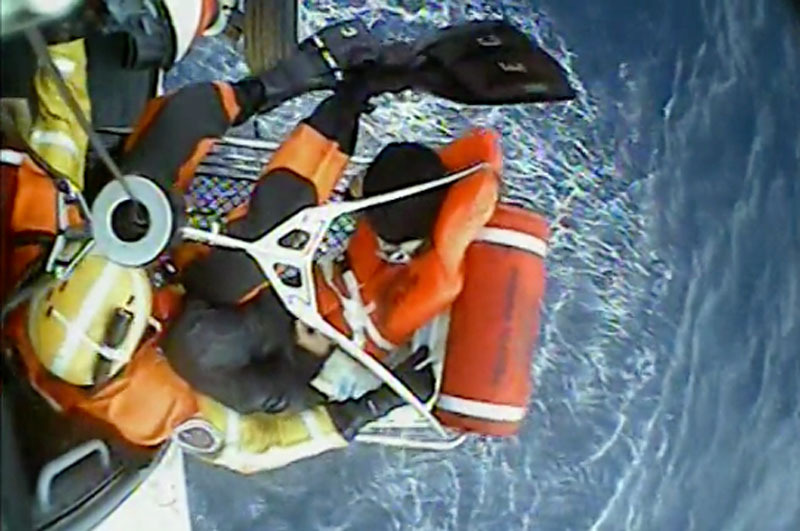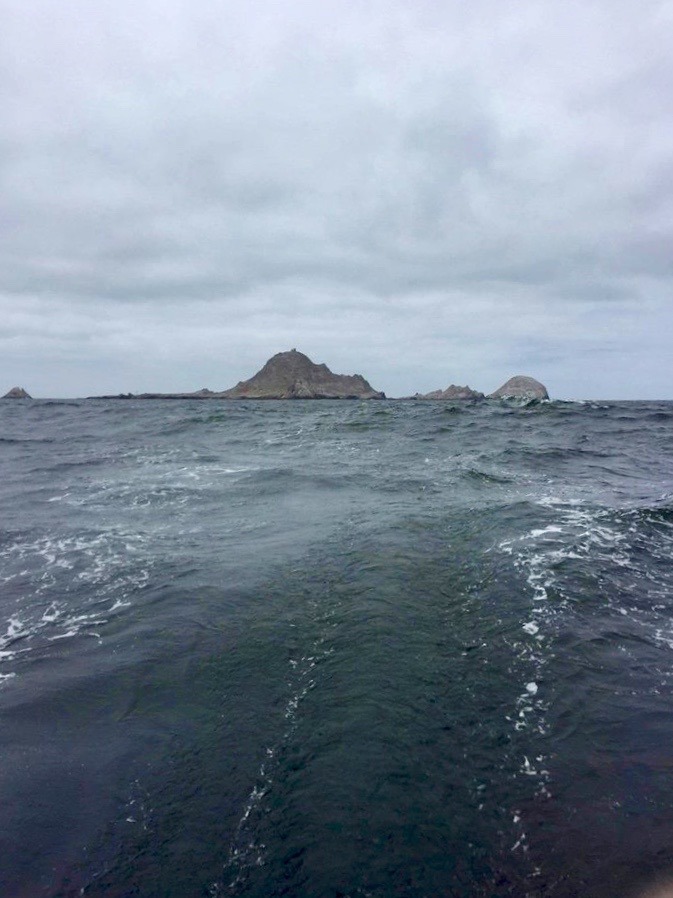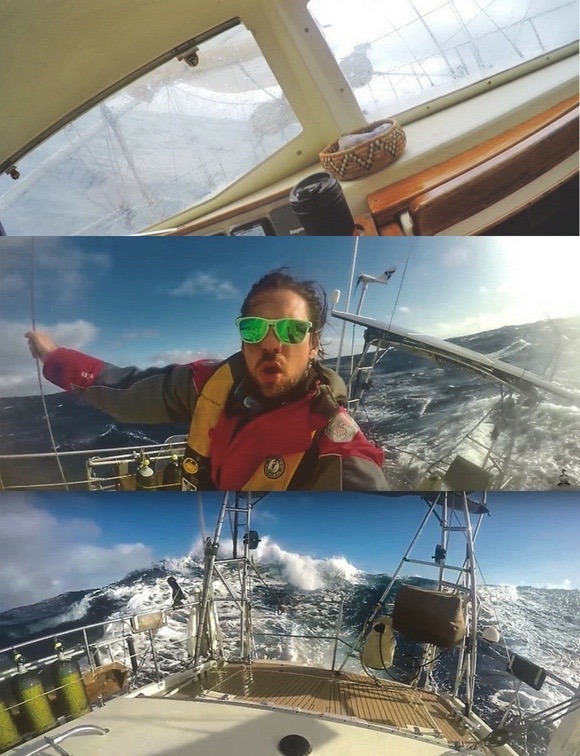
Sailors Medevaced from SoCal 300

The second event in the third California Offshore Race Week, the Coastal Cup from Monterey to Santa Barbara on May 28-29, suffered from light air, but the third passage, the SoCal 300 from Santa Barbara to San Diego by way of the Channel Islands on May 31-June 2, had breeze to spare. "The SoCal 300 was on fire," reports Mike Reed, crew aboard the SC50 Hana Ho, "with 35 knots for most of the night and two critical injuries on two different boats requiring Coast Guard air evacuation."
The USCG reports that on Thursday, May 31, a Coast Guard helicopter crew medevaced a 32-year-old man from Bob Bethink’s Rogers 46 Bretwalda3 south of Santa Cruz Island.
At 6:55 p.m., Coast Guard Sector Los Angeles-Long Beach watchstanders overheard a conversation via VHF channel 16 about an injured man aboard the boat. A Bretwalda3 crewmember reported that the man sustained a leg injury after a line wrapped around his leg, leaving it with no pulse.
After consulting with a duty flight surgeon, watchstanders dispatched a Coast Guard Air Station San Francisco Forward Operating Base Mugu MH-65 Dolphin helicopter crew to medevac the man. Coast Guard Station Channel Islands Harbor also launched a 45-ft Response Boat-Medium crew to assist.
The Dolphin crew arrived on scene, hoisted the man and transported him to Los Robles Regional Medical Center in Thousand Oaks, where he was reported to be in stable condition.
Then, in the early morning hours of Friday, June 1, a Coast Guard Sector San Diego MH-60 Jayhawk helicopter crew medevaced an injured 48-year-old woman from Jim Puckett’s Farr 57 Amazing Grace 70 miles west of San Clemente Island. At approximately 2:15 a.m. Friday, watchstanders at Coast Guard Sector San Diego’s Joint Harbor Operations Center received a request for assistance from the crew of Amazing Grace after the crewmember suffered a head injury from the boat’s boom.
A Coast Guard Sector San Diego MH-60 Jayhawk helicopter crew launched to assist. Due to the distance from shore, a Coast Guard Air Station Sacramento C-27 aircraft also launched to provide radio coverage.
At 4:39 a.m., the Jayhawk crew arrived on scene and hoisted the woman aboard the helicopter. At 6:30 a.m., she arrived at Scripps Memorial Hospital, in La Jolla. Conditions on scene consisted of eight-ft seas and 10-knot winds.
We’ll have reports from the Spinnaker Cup, Coastal Cup and SoCal 300 in Racing Sheet in the July issue of Latitude 38, including a write-up from Mike Reed.
Randall Reeves Crosses the Line
Randall Reeves is about a month away from San Francisco. The Bay Area native is returning home, and plans to make another attempt at the Figure 8 Voyage in the fall. He sent us an email over the weekend:
Greetings from Randall on Moli.
Just a note to say that we finally crossed the line early this afternoon at 152W and are back in home waters (the North Pacific) for the first time since November 20 of last year. This leg from Hobart back to San Francisco has been, at times, painfully slow, but we are now and at last about a month from the Golden Gate.
As you know, Mo and I encountered very heavy weather in the Southern Ocean this last summer. Two gales in particular caused damage to the boat that required unplanned repair stops — one in Ushuaia, Argentina, and one in Hobart, Tasmania. These put me so behind schedule that I thought it "smarter" (note quotation marks) to return home for a second try rather than attempt Cape Horn in late May, southern autumn and edging toward winter.

Once home, I’m expecting a two-month layover (at KKMI in Richmond, if they’ll have me back) before departing for a second try at the Figure 8 Voyage in October of this year. Oh, and I’ve always wondered why crossing the equator is, to sailors, called "crossing the line." But today I discovered the answer.

A Singlehanded Farallones Story
Thanks to Lia Ditton for sharing Michael Chammout’s account of the Singlehanded Farallones race with us. The following is an edited excerpt from his Facebook page. You can read a full account of the race, which was held on May 19, in the current issue of Latitude.
I found out that I somehow bagged second place in the Singlehanded Farallones Race in the non-spinnaker division! I’ve always had this bug to sail around the Farallon Islands solo, despite having never being out there before. The conditions were fierce, and 38 of the best sailors and ocean racers with their hardy, seasoned craft registered. And there was newbie me with my little, trusty Mulan.

We had 30 knots of wind at the start off GGYC, and somehow I nailed the start and led the fleet out the Golden Gate — not sure which way to go as my plan was to follow everyone! Trusting the advice of Raymond Bonneau of Corinthian YC, I went south, only to look back and see most of the fleet split north past Pt. Bonita. I carried on. Eventually there was only one other boat in sight on my tack, who, after 10 miles, broached frighteningly and turned back. The wind continued to howl at 30-plus knots with huge swells occasionally crashing and drenching over me. It was terrific and terrifying, and Mulan was solid as a rock!
After five hours of this lonely, freezing ordeal — and trusting my iPhone navigation — it was an emotional moment when suddenly, the vague silhouette of the southeast Farallon Island emerged from the fog like a mirage. I was going to make it! Adrenaline surged, and magically, a dozen or so masts and sails emerged, converging from all different directions on the island. I was third around the island as it was gusting to 35. I was jibing on my hands and knees with the huge swells drenching me, my fingernails dug in.

The return was one long reach and, finally, a moment to collect myself, have a quick drink of water and a bite of banana without taking my hand off the helm, as the autopilot couldn’t steer the boat in the huge following sea. Surfing the waves back, slowly recovering from the upwind ordeal and scary island rounding, and seeing so much of the fleet still beating upwind, I became emboldened to shake out the main reef after about 10 miles. This was a mistake. I managed the e-ride downwind on the edge, averaging 9-10 knots and hitting as much as 14 surfing down some of the huger waves. Total focus!
There was another emotional tear when those golden thin vertical lines emerged from the mist. I got into the shipping channel, weaving through several ginormous container ships coming and going, the wind still blowing 25-30. Two whales spouted and surfaced 20 yards from me. I was in it to win it and cracking off for a screaming finish. I got to the South Tower OK, but had to jibe anyway as the wind was ramping up for some odd reason. Oh shit! I got control and lined up for the GGYC finish buoy a mile away, but across the Bay at Crissy Field and to my horror, the winds were becoming 40 knots sustained and I blew up, broaching horribly, multiple times, and almost going on the rocks at St. Francis as I saw faces pinned to the windows watching. After at an eternity, I manage to crawl across the cockpit and blow the vang and get enough control to will the boat across the line in the most ugly fashion. Getting the horn was such a relief. It was 10 hours, 60 nautical miles. Second place and a T-shirt is just fine — I survived!
It’s the most intense thing I’ve ever done in my life.
SV ‘Delos’ Pt. 2
What makes for the most popular sailing channel on YouTube? Just do your thing and follow you heart, said Sailing SV Delos, the most popular sailing channel on YouTube. Last week, Brady Trautman told us that Delos’ relatability and authenticity have made their show well liked among a broad audience of sailors and non-sailors alike. We were curious how Brady how and his older brother Brian got their start in sailing.

Originally form Florida, the Trautman family spent some time in Arizona, where youngest brother Brady was born. When the family relocated back to Orlando, "Brian stayed behind in Arizona for college and eventually ended up moving to Seattle," Brady told us in an email. "For me, growing up in Orlando was awesome. I spent most of high school at the beach, and whenever I had a break from school, I would fly to visit Brian in Seattle. I can remember the first time I saw his Catalina 22. I was about 13 years old, so Brian would have been 23 or so. I vividly remember sailing around Lake Washington for hours with a boat full of awesome people and puking over the side from too much red wine. This was a common occurrence when I went to visit my older brother!"

"Although I didn’t know it at the time, I was getting the basics of sailing, little by little, on these adventures sailing with Brian. I ended up going to college for environmental engineering. After finishing my first year, I got a job in the Florida Keys at the Florida Sea Base. It’s basically a compound for 300 13- to 18-year-old Boy Scouts to come sail and dive for a week at a time in Islamorada, Florida. It was here that I really fell in love with sailing and diving. In summer 2007, I was able to get my divemaster certification and became a captain. It was the dream job, diving and driving boats all day and sailing in the afternoons. The waters are pretty shallow on the Gulf side, so I learned to sail the hard way — running into sand bars a lot.
"With all that being said, I’d say the big ‘aha’ moment came while crossing the 3,000-plus miles from Mexico to the Marquesas on Delos in 2010. Looking at weather models, planning ahead and thinking about the wind, current and weather really made everything super clear."

Should we call Sailing SV Delos reality TV? Given the ubiquity of the genre, is it important to draw a distinction anymore? For over a generation, we’ve accepted ‘regular people’ (not actors or celebrities) in front of the camera. But there was never anything real about reality TV — the hyper-produced, hyper-edited shows were engineered to foment drama, where disparate personalities were pitted against each other, and people were voted off, fired, chopped, etc. The point of so-called reality TV seems to be a ruthless, catty popularity contest far removed from anything resembling a documentary.
With YouTube, enter the self-made series. Now, ‘regular people’ aren’t just the stars, they’re producing the show. Drama is no longer integral to the formula, and one of our favorite things about Delos is that it’s surprisingly, refreshingly, delightfully drama-free (in terms of personalities. The sailing is, at times, plenty dramatic).

"Man, the Reality TV world is a strange place," Brady wrote us. "Is it scripted? Are they actors? Are they paid? It seems that drama has always sold whether it’s movies or sitcoms, but it seems like a lot of extra work to create drama like that! We’ve always been really positive individuals and feel that life is too short to worry about the little things. If anyone is having an off day, it’s pretty easy to go for a swim to the beach, a paddle on the SUP, or just hang in your cabin. We can all feel each other’s energy and respect that we’re all individuals with different struggles and off days like everyone else. I think with YouTube growing soooo fast, reality TV is dying off (although I haven’t watched TV in a long time, so what do I know?). I do know that YouTube has created a space for literally anyone to create, and there are many inspiring, creative, positive YouTube channels out there, so it’s easy to push out the negativity and drama, you just have to make that choice."
In case you missed last week’s call-out, we’d like to know what you think about Sailing SV Delos and YouTube sailors in general.
